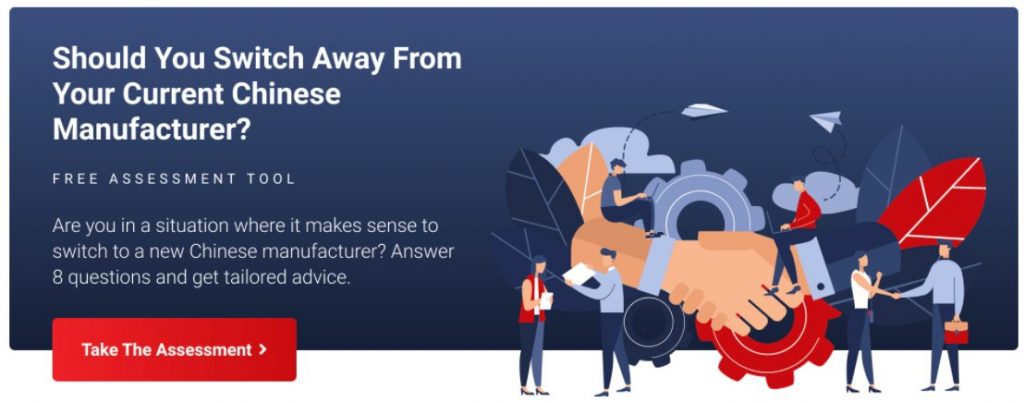Many times, importers ask me “how to control production better?”, and they proceed to give me examples of the recent issues they have had with their current Chinese supplier. And I often tell them “switch to a better supplier“.
Now, making a switch is not always easy. It takes preparation.
On the one hand, a new factory has to be identified and vetted. They need to be onboarded and trained to your requirements. They probably need to find sources, they may need to adapt their internal processes. They might need time (and you may have to build more inventory.) Who knows, they might end up being as bad as your current source.
And, on the other hand, you have to assume the current supplier will not be happy about the switch. If you don’t have solid and enforceable agreements with them, they might hold your tools or your materials & products hostage. They might even sell your product to your direct competitors.
Because of all this, importers get in an “analysis paralysis”, and they keep their dysfunctional supply chain in place for years. They lack sleep, they lose customers, they make a lower profit overall than they should. The status quo takes a huge toll.
So, what should be sufficient to push you to develop a new supplier — to be kept as a backup, as a second source, or as the replacement to your current source?
I came up with a list of 7 reasons why you should switch to a new supplier.
1. The quality is not acceptable
This is probably the most common sign of a bad supplier. You receive batches of products that are markedly substandard.
Over the years, we ended up with a simple rule of thumb: if the first batch made by a factory is not acceptable, switch now! Giving a re-order is usually a big mistake. Many people seem to agree.
There might be a variety of reasons for it, but none are good excuses:
- They don’t understand your standard and your requirements (did they even ask?)
- Their main customers operate on a market that can accept much poorer finishing than yours (did they try to communicate the standard they were comfortable achieving?)
- They received components (or even whole products if they subcontracted the whole process), didn’t inspect quality, and/or decided they wouldn’t try and fix it.
(There are, of course, also good excuses. For example, your product design is far from mature and couldn’t be made consistently within specifications. Or you directed a component supplier that messed up. However, good factories will often detect it and let you know.)
2. They raise prices very fast without clear justifications
That is, unfortunately, a common problem. They see you as a cow to milk for all it’s worth.
They don’t give you a P&L statement about what their margin is on your product. They don’t even give you any firm number. They mention a rise in the cost of some materials, higher wages, a lower RMB… and they bump the price you pay up by 10% or 20% a year.
And it usually leads to haggling exchanges. “I can pay a bit more, but no more than 3%”, “We can make a big effort and raise only 10%, but we’ll make no money”, and so on.
That’s unpleasant and usually unsustainable in the long run. As the buyer, this should drive you to build a backup supplier in order to have an alternative (and to jump ship completely if the current supplier gets too unreasonable).
3. You find out that they have used your IP without authorization
This is not very common (fortunately) and is not always easy to prove, but it does happen and it is absolutely shocking. We listed 10 examples of IP theft before.
You spent resources designing your own product. You worked with a manufacturer to develop and make it. And yet, you find out that they also sold it to other companies. Or, even worse, that they have become your direct competitor on your market.
I have seen buyers get very upset and nasty in this case, ending the relationship immediately.
Other buyers keep their cool, don’t divert orders away from that reckless supplier, and discreetly start looking for a new source for their new products.
I can understand both reactions, and each may make sense depending on the buyer’s business model…
4. The manufacturer keeps making changes without your authorization
Many Chinese factories operate on the principle that “the customer pays to receive finished products, and we don’t need to tell them HOW we do our work”. Unfortunately, that causes many expensive surprises for the buyer.
This may take several forms:
- Unauthorized subcontracting, even though one manufacturing facility was audited and authorized. This usually leads to very inconsistent quality.
- Unauthorized change of a key component, usually because they found a cheaper source or because it will make assembly easier. This often has implications that the manufacturer thinks are negligible… but in some cases, they can make the product unsuitable for sale/use!
- Unauthorized change in a process, again in order to save money or make things easier. And again, with consequences that might be very expensive.
If they don’t have a proper process for managing engineering changes, do you think they will set one up just for you? And do you think their purchasers, their engineers, and their production supervisors will follow that process every time they want to make a change? That doesn’t sound realistic.
5. They are in dire financial straits
You may see or hear many signs that your key supplier is not in a stable financial situation. You might notice that they lost their N0. 1 customer. They might mention they rented some of the floors to another factory, as they need less space. They may owe money to their own suppliers. Some key staff are leaving. And so on.
The risk for you, the buyer, is obvious:
- They might collect an advance payment on a production and then shut down.
- If they use tooling that you paid for, you are unlikely to be able to get it back. It might be sold (maybe for scrap!) by unhappy creditors and employees trying to get some money back.
- Same thing for materials, semi-finished products, samples, testing equipment, etc.
If it will take you 6 months to onboard and train a new supplier, and if you only have 2 months of inventory, imagine your supply of products is interrupted suddenly. That might be a disaster.
6. Evidence of serious ethical/social/environmental wrongdoing
If you are worried about bad press, or if you simply can’t accept certain types of wrongdoing, this might be the trigger that drives you to work with a new factory.
In my years, I have seen all sorts of bad behaviors, from very dangerous working conditions (think ‘pouring molten metal while wearing a T-shirt’) to dumping chemical waste in rivers. And some factory owners operate on such a short term view, they are unwilling to change their approach.
Don’t keep working with them. They probably apply the same shady mindset when managing your product quality and your confidential information.
7. A different supplier is a more attractive option (cost/processes/ability/etc)
And finally, the obvious… You find a new supplier that is clearly better than your current one.
- Maybe they give you a simple and clear pricing structure and give you an attractive quotation.
- Maybe you develop new products regularly and you need to rely on a factory that has a strong NPI process.
- Maybe they have a strong quality system, clear visual management systems, and well train staff.
I could keep going, but in short, this new supplier has what you need and can respond to your needs markedly better.
—————————-
UPDATE 21 Apr. 2022 – one more reason is diversifying your sources away from China, if you are very exposed to the “China as a source” risk. That makes particular sense if your main market is the USA.
I wrote about this in How To Diversify Manufacturing Sources Out of China and Cut Risk.
*****
To add to these 7 common reasons, there are factors that make it even more important to switch. Here are a few typical ones:
- The current supplier refuses to sign a fair and balanced manufacturing agreement, meaning that they are not motivated to get any better.
- You are given only one contact window, which is not cooperating well, and you can’t get in touch with anybody else. (That leads to serious risks, as that person might leave or become disinterested in your projects.)
- When discussions get heated, they outright threaten you to take your products and/or tooling hostage. This is absolutely shocking (as long as the buyer has held their end of the deal), but it happens more often than one might expect.
*****
If you decide to switch to a new Chinese supplier, how do you manage the process of transferring production between them? Read this blog post: 7 Tips to Manage the Transfer of Production To Another Chinese Factory
Do these 7 signs remind you of your current Chinese supplier?
I know it’s a big decision, so to make it easier I’ve created an assessment over at our Contract Manufacturing subsidiary, Agilian Technology, where you answer a series of 8 simple questions about your relationship and results from your current supplier and will be provided with a tailored response from us about if you truly should consider switching supplier right now.
It’s free and there’s no download required. Hit the image below to take the assessment:


